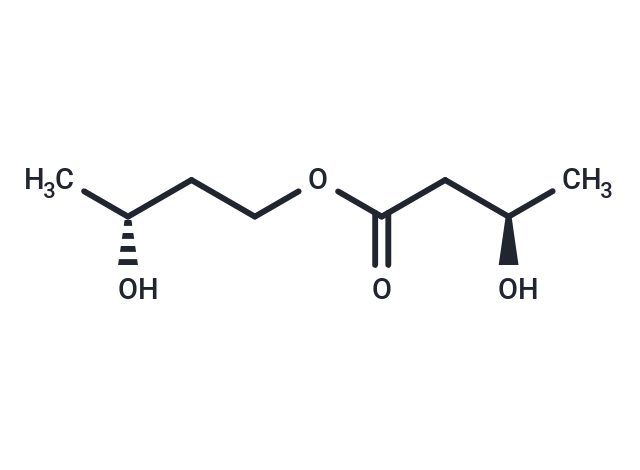Shopping Cart
- Remove All
 Your shopping cart is currently empty
Your shopping cart is currently empty

BD-AcAc 2 (Ketone Ester) is a ketone monoester and can be used as a source of oral nutritional ketones. BD-AcAc 2 can elevate plasma levels of acetoacetate and β-hydroxybutyrate, blood Na+, blood glucose levels and blood creatinine levels after oral administration in mice. BD-AcAc 2 can partly prevent muscle weakness in septic mice. BD-AcAc 2 exhibits potential to improve endurance and exercise performance in animal body. BD-AcAc 2 can also be used to research diabetes or Parkinson's disease.

| Pack Size | Price | Availability | Quantity |
|---|---|---|---|
| 5 mg | $38 | In Stock | |
| 10 mg | $53 | In Stock | |
| 25 mg | $89 | In Stock | |
| 50 mg | $133 | In Stock | |
| 100 mg | $197 | In Stock |
| Description | BD-AcAc 2 (Ketone Ester) is a ketone monoester and can be used as a source of oral nutritional ketones. BD-AcAc 2 can elevate plasma levels of acetoacetate and β-hydroxybutyrate, blood Na+, blood glucose levels and blood creatinine levels after oral administration in mice. BD-AcAc 2 can partly prevent muscle weakness in septic mice. BD-AcAc 2 exhibits potential to improve endurance and exercise performance in animal body. BD-AcAc 2 can also be used to research diabetes or Parkinson's disease. |
| In vivo | BD-AcAc(2) would delay CNS-OT seizures in rats breathing hyperbaric oxygen (HBO(2)). Adult male rats (n = 60) were implanted with radiotelemetry units to measure electroencephalogram (EEG). One week postsurgery, rats were administered a single oral dose of BD-AcAc(2), 1,3-butanediol (BD), or water 30 min before being placed into a hyperbaric chamber and pressurized to 5 atmospheres absolute (ATA) O2 [1]. Beginning at a presymptomatic age, 2 groups of male 3xTgAD mice were fed a diet containing a physiological enantiomeric precursor of ketone bodies (KET) or an isocaloric carbohydrate diet. The results of behavioral tests performed at 4 and 7 months after diet initiation revealed that KET-fed mice exhibited significantly less anxiety in 2 different tests. 3xTgAD mice on the KET diet also exhibited significant, albeit relatively subtle, improvements in performance on learning and memory tests. Immunohistochemical analyses revealed that KET-fed mice exhibited decreased Aβ deposition in the subiculum, CA1, and CA3 regions of the hippocampus, and the amygdala [2]. |
| Alias | Ketone Ester |
| Molecular Weight | 176.21 |
| Formula | C8H16O4 |
| Cas No. | 1208313-97-6 |
| Smiles | C[C@@H](O)CCOC(=O)C[C@@H](C)O |
| Relative Density. | 1.102 g/cm3 |
| Storage | Powder: -20°C for 3 years | In solvent: -80°C for 1 year | Shipping with blue ice. | |||||||||||||||||||||||||||||||||||
| Solubility Information | DMSO: 96 mg/mL (544.80 mM), Sonication is recommended. H2O: 30 mg/mL (170.25 mM), Sonication and heating to 60℃ are recommended. | |||||||||||||||||||||||||||||||||||
Solution Preparation Table | ||||||||||||||||||||||||||||||||||||
H2O/DMSO
| ||||||||||||||||||||||||||||||||||||

Copyright © 2015-2025 TargetMol Chemicals Inc. All Rights Reserved.